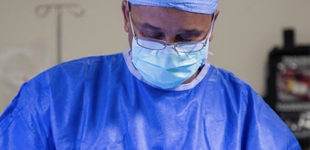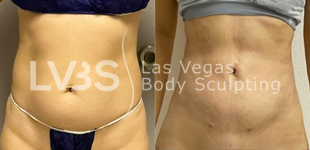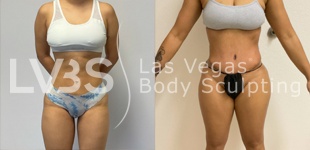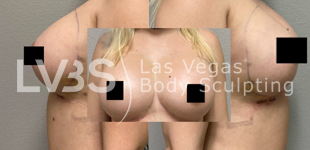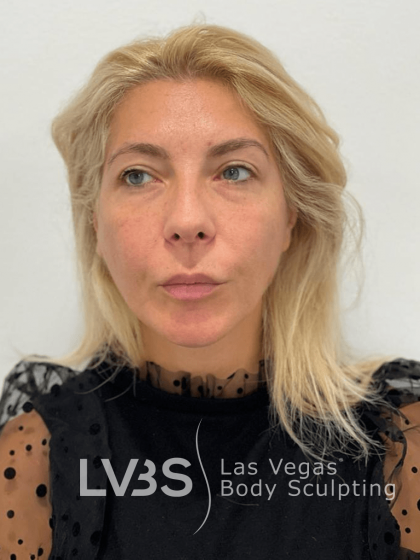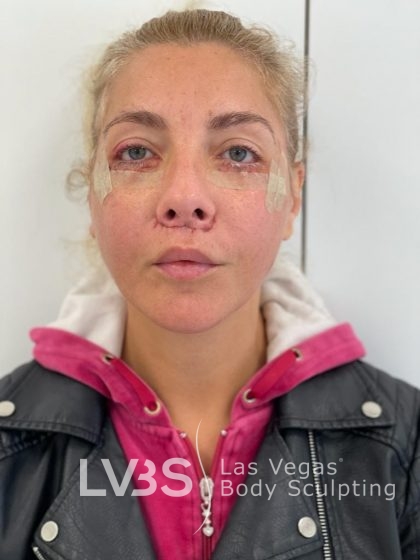Facelift (Deep Plane)
Conveniently located to serve the areas of Las Vegas and Henderson, NV

Deep Beauty
A deep plane facelift is a type of facial surgery that lifts and tightens the deep structures of the face, such as the muscles and connective tissue, to improve the appearance of sagging or drooping skin. This procedure is typically more invasive than a traditional facelift, as it requires incisions in the deeper layers of the skin. A deep-plane facelift aims to create a more youthful and rejuvenated appearance by addressing the underlying causes of facial aging rather than just the surface-level changes in the skin.
Dr. Mustafa Ahmed has the skills and certification deep plane facelift requires. This is not a surgery to be taken lightly and not a time to risk your safety and results to an unqualified surgeon. Dr. Ahmed is triple-board certified and is honored to deliver this incredible surgery to the patients of Las Vegas at Las Vegas Body Sculpting and Aesthetic. Transform your face, change your life; call today. In Nevada and the Las Vegas area, call our scheduling coordinator at (702) 447-1257 or fill out our online form, and we will get back to you shortly.Follow the blog of Dr. Ahmed for an in-depth look at cosmetic procedures and treatments to keep you looking young for years to come.
Contents
- 1 Before and After Photos
- 2 About Deep Plane Facelift
- 3 What are the Benefits of a Deep Plane Facelift?
- 4 Who is the Ideal Candidate for Deep Plane Facelift?
- 5 Personal Consultation
- 6 Preparing for Surgery
- 7 The Procedure
- 8 Recovering from Surgery in Las Vegas
- 9 What are the Results of the Deep Plane Facelift with Dr. Ahmed?
- 10 What is the Cost of a Deep Plane Facelift in Las Vegas?
- 11 References
Before and After Photos
About Deep Plane Facelift
The deep plane facelift is a modification of traditional facelift techniques that address common changes that occur in the midface with aging, such as deep nasolabial folds and sagging of the superficial (malar) fat pads. This procedure involves dissection in the sub-SMAS plane in the lower cheek and a supra-SMAS dissection in the upper cheek creating a flap of skin, muscle, and fat. [1]
A skilled surgeon easily identifies the various layers of the face, including the:
- Skin
- Subcutaneous tissues
- Superficial fascia
- Deep fascia
The arrangement of the layers that make up the structure of the face, from superficial to deep, is consistent. [2] However, the attachments of these layers and the volume of each layer can vary as an individual ages. Despite the fact that the names of these layers may differ in different regions of the face and neck, their relationship is constantly connected.
However, the position and relationships of the muscles, nerves and vascular structures with the layers may vary. This, the skilled surgeon understands and addresses with a deep plane facelift.
The Aging Face
A deep-plane facelift addresses the connected causes of facial aging rather than just the surface-level changes that occur in the skin. As we age, the SMAS begins to thin and sag, which can contribute to the appearance of shifting, hollowing, and an overall aged face. [3] A deep plane facelift can lift and tighten the SMAS, creating a naturally-youthful face.
As a patient with consistently stable weight ages, facial fat volume decreases, and the superficial facial fat pads descend. Additionally, the strength of facial ligaments weakens with age, contributing to the soft tissues’ descent. Repositioning the descended tissues to a more youthful position on the mid-face restructures the patient’s overall aesthetic. It acts as a positive domino effect, restoring connected tissues like the skin and superficial fat to their lifted position.
What are the Benefits of a Deep Plane Facelift?
The deep plane facelift requires a longer recovery period, but the benefits once healed are outstanding. These benefits include:
- Improved contours – A deep plane facelift can improve the contour of the face by lifting and tightening the deep structures of the face, such as the muscles and connective tissue.
- Natural-looking results – Instead of a “pulled” or “done” look, the deep plane facelift is designed to address the underlying causes of facial aging rather than just the surface-level changes that occur in the skin.
- Long-lasting results – A deep plane facelift can produce longer-lasting results compared to other facial rejuvenation procedures, as it addresses the face’s underlying structures rather than just the surface-level skin changes.
- Customizable procedure – To achieve the desired results, a deep plane facelift can be customized to address specific concerns and goals, such as sagging in the midface or jowls.
To see how the deep plane facelift has benefited Dr. Ahmed’s patients, check out our before and after gallery.
Who is the Ideal Candidate for Deep Plane Facelift?
The ideal candidate for a deep plane facelift is someone who is experiencing sagging or drooping in the midface or lower face due to aging or other factors and who desires a more youthful and rejuvenated appearance. A deep plane facelift can be particularly effective for those who have lost significant volume in their midface due to aging.
In general, good candidates for a deep plane facelift are:
- In good physical and mental health
- Non-smokers
- Realistic in their expectations
- Able to take time off work and other commitments for recovery
It is important to discuss your goals and expectations with Dr. Ahmed before deciding if a deep plane facelift is right for you. He will assess your overall health, skin quality, and facial anatomy to determine if you are a good candidate for the procedure.
Personal Consultation
During a deep plane facelift consultation, Dr. Ahmed will evaluate your medical history, conduct a physical examination of your face, and discuss your cosmetic goals and expectations. This will typically involve:
- Reviewing your medical history
- Asking about any medical conditions you have
- Reviewing medications you are taking
- Discussing any previous surgeries you have had
Dr. Ahmed will examine your face, including the skin, muscles, and a superficial assessment of underlying structures to assess the condition of your facial tissues and identify areas that may benefit from treatment. Being open and honest with Dr. Ahmed about your cosmetic goals and expectations is important. He will listen to your concerns and help you understand what results you can realistically expect from the procedure.
Dr. Ahmed will also explain the details of the deep plane facelift procedure, including the risks and potential complications, the recovery process, and the costs involved. It is important to ask questions and fully understand the procedure before deciding if a deep plane facelift is right for you.
Preparing for Surgery
Once you have settled on a deep plane facelift for your cosmetic improvement, we will outline steps that you can take to ensure your successful procedure and recovery. Following these steps is important, including:
- Stopping smoking – Smoking can interfere with the healing process and increase the risk of complications after surgery. It is important to stop smoking at least six weeks before and after your deep plane facelift.
- Avoiding certain medications – Certain medications, such as aspirin and nonsteroidal anti-inflammatory drugs (NSAIDs), can increase the risk of bleeding and should be avoided in the weeks leading up to surgery. We will provide you with a list of medications to avoid.
- Preparing your home – Make sure you have someone to help you at home for the first few days after surgery, as you will need assistance with daily tasks. Stock up on supplies, such as ice packs, bandages, and over-the-counter pain medication. You will also need to fill any prescriptions Dr. Ahmed prescribes.
- Arranging for transportation – You will not be able to drive after your deep plane facelift, so make sure you have arranged for someone to drive you home from the surgical center.
We will provide you with specific instructions to follow in the weeks leading up to your surgery, such as avoiding certain foods and drinks and avoiding alcohol. It is important to follow these instructions carefully to ensure the best possible outcome.
Your safety and success are our number one concern. Start with a consultation, and you’ll be on the road to recovery before you know it. Call (702) 447-1257 today!
The Procedure
The exact steps of the procedure will vary depending on the specific needs and goals of the patient. All patients under Dr. Ahmed’s care will be given general anesthesia by a board-certified anesthesiologist. This means that patients will be asleep during surgery and will not feel anything.
Dr. Ahmed will make strategically placed incisions focusing on accessing the SMAS while also reducing visible scarring after surgery. These incisions may be in the hairline, behind the ears, and possibly in the lower eyelids or inside the mouth. Once he has access, Dr. Ahmed will dissect the underlying tissues in the deep plane, separating them from the facial muscles and connective tissue so they can be lifted and restructured. The surgery ends with sutures, bandaging, compression garments, and tubes to relieve pressure.
Deep plane surgery typically takes several hours to complete, depending on the extent of treatment. After the procedure, the patient will be taken to a recovery room to be monitored until the effects of the anesthesia have worn off.
Recovering from Surgery in Las Vegas
Recovery from a deep plane facelift typically involves significant swelling, bruising, and soreness, which can last for several weeks. Most patients will need to take about two weeks off work and other normal activities to allow for proper healing.
- It is important to follow Dr. Ahmed’s instructions for caring for your incisions, taking medications, and engaging in physical activity.
- Sleeping with your head elevated can help reduce swelling and discomfort.
- Applying cold compresses to the face can help reduce swelling and discomfort.
- It is important to avoid strenuous activity, such as lifting heavy objects or engaging in intense exercise, until your surgeon gives you the go-ahead.
- It is important to protect your face from the sun while it is healing. Wear a hat or sunscreen with a high SPF when outdoors.
- Attending all follow-up appointments is important to ensure your recovery is progressing as expected.
Recovery from a deep plane facelift can be a long and uncomfortable process, but most patients find the results worth it. It is important to be patient and to follow your surgeon’s instructions to ensure the best possible outcome.
What are the Results of the Deep Plane Facelift with Dr. Ahmed?
The results of a deep plane facelift can vary depending on the specific concerns and goals of the patient, as well as the individual’s anatomy and healing process. A deep plane facelift can produce a more youthful and rejuvenated appearance. Patients will see wrinkles and sagging skin disappear and be replaced by a more youthful contour to the face.
Improved appearance can positively impact a patient’s life in many ways. Many people feel more confident and self-assured after a facial rejuvenation procedure, which can improve their social and professional relationships. In some cases, a more youthful appearance can even lead to new opportunities and experiences!
Enjoy your life with renewed zest and energy when you look as young as you feel. Dr. Ahmed’s patients experience an overall boost in most areas.
What is the Cost of a Deep Plane Facelift in Las Vegas?
The surgery cost will depend on many factors, which Dr. Ahmed and his team will discuss during your consultation. Don’t let your aging face distract from how young you feel. Call Las Vegas Body Sculpting and Aesthetics today at (702) 447-1257. We look forward to revealing your beautifully youthful face.
References
- Hamra ST. The deep-plane rhytidectomy. Reconstructive Surgery. 1990;86(1):53-61; discussion 62-63. Accessed January 8, 2023. https://pubmed.ncbi.nlm.nih.gov/2359803/
- Cotofana S, Lachman N. Anatomy of the Facial Fat Compartments and their Relevance in Aesthetic Surgery. JDDG: Journal der Deutschen Dermatologischen Gesellschaft. 2019;17(4):399-413. doi:10.1111/ddg.13737
- Gosain AK, Klein MH, Sudhakar PV, Prost RW. A Volumetric Analysis of Soft-Tissue Changes in the Aging Midface Using High-Resolution MRI: Implications for Facial Rejuvenation. Reconstructive Surgery. 2005;115(4):1143-1152. doi:10.1097/01.prs.0000156333.57852.2f

